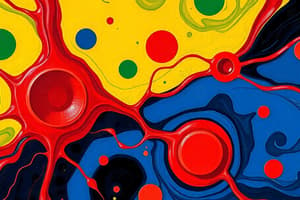Podcast
Questions and Answers
What is the primary purpose of hemostasis?
What is the primary purpose of hemostasis?
- To prevent excessive bleeding (correct)
- To enhance blood circulation
- To promote platelet production
- To increase blood clotting factors
Which of the following factors is involved in the extrinsic pathway of coagulation?
Which of the following factors is involved in the extrinsic pathway of coagulation?
- Factor IX
- Factor X
- Factor XII
- Factor III (correct)
How are clotting factors typically inactivated before becoming active?
How are clotting factors typically inactivated before becoming active?
- They're phosphorylated
- They're bound by calcium ions
- They're converted into zymogens (correct)
- They're oxidized by free radicals
Which statement about the intrinsic pathway of coagulation is correct?
Which statement about the intrinsic pathway of coagulation is correct?
What is the role of calcium in the coagulation cascade?
What is the role of calcium in the coagulation cascade?
What is the function of the common pathway in coagulation?
What is the function of the common pathway in coagulation?
Which factor is a serine protease involved in coagulation?
Which factor is a serine protease involved in coagulation?
What happens when a clotting factor becomes activated?
What happens when a clotting factor becomes activated?
Which factor is primarily responsible for converting prothrombin into thrombin during the common pathway of coagulation?
Which factor is primarily responsible for converting prothrombin into thrombin during the common pathway of coagulation?
What is the primary role of thrombin in the coagulation cascade?
What is the primary role of thrombin in the coagulation cascade?
Which statement about von Willebrand disease is correct?
Which statement about von Willebrand disease is correct?
What condition results from a deficiency of vitamin K?
What condition results from a deficiency of vitamin K?
Which of the following factors is not involved in the intrinsic pathway of coagulation?
Which of the following factors is not involved in the intrinsic pathway of coagulation?
Which type of hemophilia is caused by a deficiency in factor IX?
Which type of hemophilia is caused by a deficiency in factor IX?
What is the end product of the cleavage of fibrinogen by thrombin?
What is the end product of the cleavage of fibrinogen by thrombin?
What common outcome may occur due to coagulation disorders?
What common outcome may occur due to coagulation disorders?
What is the role of factor XIIIa during the clotting process?
What is the role of factor XIIIa during the clotting process?
During which stage of the coagulation cascade is fibrin first produced?
During which stage of the coagulation cascade is fibrin first produced?
Study Notes
Hemostasis
- Hemostasis is the process of stopping bleeding.
- It is a complex process involving both primary and secondary hemostasis.
- Primary hemostasis forms an unstable platelet plug at the site of injury.
- Secondary hemostasis involves the coagulation cascade, a series of steps that activate clotting factors to stabilize the platelet plug.
Coagulation Cascade
- The coagulation cascade consists of a series of reactions that lead to the formation of a stable blood clot.
- It involves the activation of a series of clotting factors, which are proteins that are involved in blood clotting.
- Clotting factors are initially in an inactive form called zymogens.
- When activated, they become proteases, enzymes that speed up the breakdown of other proteins.
Pathways of Coagulation
- There are three pathways in the coagulation cascade: extrinsic, intrinsic, and common.
- The extrinsic pathway is initiated by tissue factor (factor III) exposed after tissue injury.
- Tissue factor binds with calcium and factor VIIa to activate factor X.
- The intrinsic pathway is activated when factor XII is exposed to collagen, kallikrein, and high molecular weight kininogen (HMWK).
- Factor XIIa activates factor XI into XIa, which in turn activates factor IX with calcium.
- Factor IXa, factor VIIIa, and calcium form a complex to activate factor X.
- Both the extrinsic and intrinsic pathways lead to the activation of factor X, which initiates the common pathway.
Common Pathway
- The common pathway begins with the formation of a prothrombinase complex, consisting of factor Xa, Va, and calcium.
- Prothrombinase activates prothrombin (factor II) into thrombin (factor IIa).
- Thrombin cleaves fibrinogen (factor I) into fibrin (factor Ia), which forms a mesh-like structure that stabilizes the blood clot.
- Thrombin also activates factors V, VIII, and IX, further amplifying the coagulation cascade.
Fibrin Production
- Fibrin, a long, thin protein with branches, is produced when fibrinogen is converted to fibrin.
- Fibrin stabilizes the blood clot.
Goal of Coagulation
- The main goal of coagulation is to form a stable blood clot, stopping bleeding and allowing time for tissue repair.
Coagulation Disorders
- Coagulation disorders affect the coagulation cascade and impair blood clotting.
- Common disorders include:
- Von Willebrand disease (deficiency in von Willebrand factor)
- Hemophilia (deficiencies in factor VIII, factor IX, or factor XI)
- Vitamin K deficiency (impaired function of factors II, VII, IX, and X).
- All these disorders can lead to excessive bleeding.
Studying That Suits You
Use AI to generate personalized quizzes and flashcards to suit your learning preferences.
Description
This quiz covers the essential processes of hemostasis and the coagulation cascade. It delves into primary and secondary hemostasis, the activation of clotting factors, and the three pathways of coagulation. Test your knowledge on the formation of blood clots and the critical steps involved in stopping bleeding.




